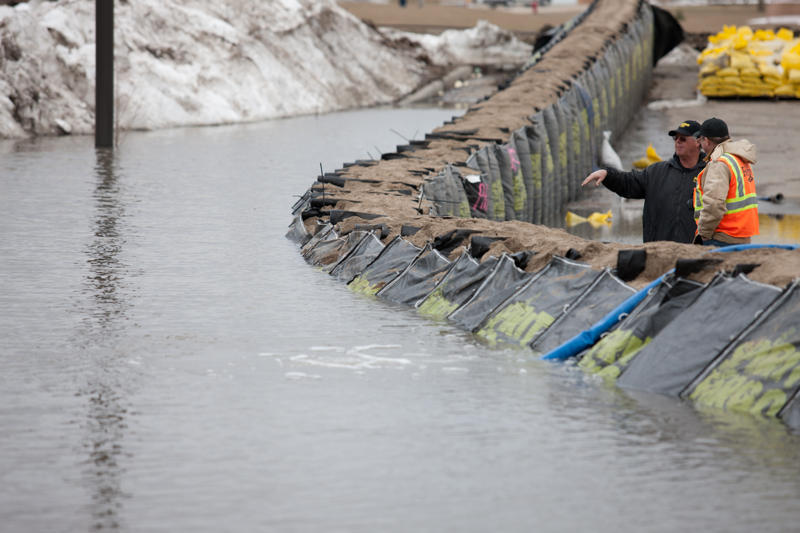What Is a Water Gate Flood Barrier?
Daniel Déry invented the water gate flood barrier in 1998 after seeing the overflow of the Red River the previous year that took the lives of hundreds of people. He wanted to find an alternative to traditional sandbags that could be used during an unexpected disaster.
Water gate barriers are essentially large, empty plastic bags that self-deploy to create a temporary seal, keeping water out. This system works by allowing the water in, forcing the base down, while also lifting the top to form a strong barrier against the flow of water.
How Water Gates Provide Flood Control
Water gates protect someone’s property from flooding by surrounding the area, keeping the flooding water out. The system is portable and can be rolled up for easy storage. A small barrier can even be carried by a single person, or larger barriers can be kept in a small truck. Water gate barriers are quick to deploy, taking only a few minutes for a solution during emergency flooding.
What Is a Flood Bag?
A flood bag is a cell made of high-strength textile and filled with material such as sand or gravel for a temporary flood solution. The fill material must weigh 100 pounds per cubic foot when compacted. Flood bags are sloped on one side and open at the top where the filling can be added. The flood bags are connected on each side, forming a strong barrier to redirect the flow of flood water and protect someone’s home, life, and belongings.
How to Use Flood Bags for Flood Control
Flood bags can be used as barriers, forming a pentagon shape that pulls out like an accordion and is self-reliant and prevents leaks. The barriers are collapsable, allowing them to be easily stored. Flood bags do not require ground infiltration to install, making them an effective emergency solution.
Flood bags are also highly versatile and can be used to form:
- Cofferdams: Cofferdams are used in a body of water or a flooded area and can pump the water out, creating a dry environment.
- Dams: Dams can be constructed to temporarily or permanently keep water from entering an area during a flood.
- Dikes: Dikes can prevent water from entering a property from a nearby waterway, such as a lake or river. Diversion dikes can also be used to redirect the flow of water.
- Levees: Levees can also be used to prevent flooding from nearby rivers that have overflowed. Flood bags can be used to create a levee or can be added on top of an existing levee for extra height and protection.
Why TrapBag Is the Superior Flood Control Product
Which Is Better: Flood Bags or Water Gates?
Flood bags and water gates accomplish similar things. Both structures are meant to keep water out and control flooding. However, water gates don’t deploy until flooding has already occured, since their deployment requires weight from the water. It can be risky to rely on the water gate to self-deloy during a flood, and they aren’t as sturdy as other barrier methods.
On the other hand, TrapBag flood barriers can be installed ahead of time to prevent damage from flooding before it starts. Flood bags are also more versatile and can be used in the form of cofferdams, dams, levees, and other structures. This is why flood bags are often the best solution.
The Best Flood Bag on the Market: TrapBags
There are a range of benefits that come with choosing TrapBag flood bags, including:
- More affordable: TrapBags are cost effective since they can be filled with less material. They also do not require ground infiltration for installation, saving money on heavy machinery and labor costs.
- Rapid deployment: TrapBags can be set up quickly for fast-acting flood control and prevention without the need for ground infiltration. The TrapBags come as a chain of cells and are pulled out like an accordion. About 100 linear feet of four-foot-tall TrapBags can be installed in just 30 minutes, replacing 8,000 sandbags.
- Versatile: TrapBags can be used as dams, cofferdams, dikes, levees, seawalls, and more to offer the solution you need. They can also be filled with sand or rocks for a temporary solution, or act as permanent barriers when filled with concrete. TrapBags come in 50-foot sections that can be connected depending on the size of the area.
- High strength: TrapBags provide a 3-to-1 safety factor. They last out in the UV for at least five years.
- Requires less fill material: TrapBags require 40% less material than traditional sandbags, and one 100-foot, four-foot-high section can replace approximately 8,000 traditional sandbags.
Control Flooding with the Industry’s Leading Flood Bag
TrapBags offer the best flood bag and flood barrier solutions. If you need protection from flooding or want an emergency system in case of an unexpected flood, TrapBags has the barrier that you need. Contact us today to learn more.


